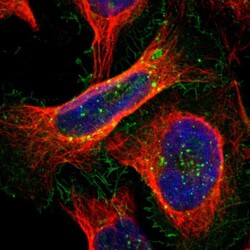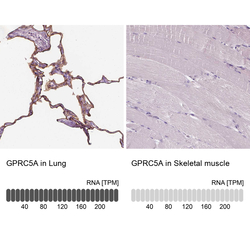Antibody data
- Antibody Data
- Antigen structure
- References [8]
- Comments [0]
- Validations
- Immunocytochemistry [1]
- Immunohistochemistry [1]
Submit
Validation data
Reference
Comment
Report error
- Product number
- HPA007928 - Provider product page

- Provider
- Atlas Antibodies
- Proper citation
- Atlas Antibodies Cat#HPA007928, RRID:AB_1849318
- Product name
- Anti-GPRC5A
- Antibody type
- Polyclonal
- Description
- Polyclonal Antibody against Human GPRC5A, Gene description: G protein-coupled receptor, class C, group 5, member A, Alternative Gene Names: GPCR5A, RAI3, RAIG1, Validated applications: WB, IHC, ICC, Uniprot ID: Q8NFJ5, Storage: Store at +4°C for short term storage. Long time storage is recommended at -20°C.
- Reactivity
- Human
- Host
- Rabbit
- Conjugate
- Unconjugated
- Isotype
- IgG
- Vial size
- 100 µl
- Concentration
- 0.2 mg/ml
- Storage
- Store at +4°C for short term storage. Long time storage is recommended at -20°C.
- Handling
- The antibody solution should be gently mixed before use.
Submitted references GPRC5A promotes lung colonization of esophageal squamous cell carcinoma
Crystalline silica particles cause rapid NLRP3-dependent mitochondrial depolarization and DNA damage in airway epithelial cells
RhoA/C inhibits proliferation by inducing the synthesis of GPRC5A.
Adaptive RSK-EphA2-GPRC5A signaling switch triggers chemotherapy resistance in ovarian cancer.
Single-cell transcriptomics reveals multi-step adaptations to endocrine therapy
GPCRomics: GPCR Expression in Cancer Cells and Tumors Identifies New, Potential Biomarkers and Therapeutic Targets
Orphan G protein-coupled receptor GPRC5A modulates integrin β1-mediated epithelial cell adhesion
GPRC5A is a potential oncogene in pancreatic ductal adenocarcinoma cells that is upregulated by gemcitabine with help from HuR
Zhou H, Tan L, Zhang B, Kwong D, Wong C, Zhang Y, Ru B, Lyu Y, Siu K, Luo J, Yang Y, Liu Q, Chen Y, Zhang W, He C, Jiang P, Qin Y, Liu B, Guan X
Nature Communications 2024;15(1)
Nature Communications 2024;15(1)
Crystalline silica particles cause rapid NLRP3-dependent mitochondrial depolarization and DNA damage in airway epithelial cells
Wu R, Högberg J, Adner M, Ramos-Ramírez P, Stenius U, Zheng H
Particle and Fibre Toxicology 2020;17(1)
Particle and Fibre Toxicology 2020;17(1)
RhoA/C inhibits proliferation by inducing the synthesis of GPRC5A.
Richter L, Oberländer V, Schmidt G
Scientific reports 2020 Jul 27;10(1):12532
Scientific reports 2020 Jul 27;10(1):12532
Adaptive RSK-EphA2-GPRC5A signaling switch triggers chemotherapy resistance in ovarian cancer.
Moyano-Galceran L, Pietilä EA, Turunen SP, Corvigno S, Hjerpe E, Bulanova D, Joneborg U, Alkasalias T, Miki Y, Yashiro M, Chernenko A, Jukonen J, Singh M, Dahlstrand H, Carlson JW, Lehti K
EMBO molecular medicine 2020 Apr 7;12(4):e11177
EMBO molecular medicine 2020 Apr 7;12(4):e11177
Single-cell transcriptomics reveals multi-step adaptations to endocrine therapy
Hong S, Chan T, Lombardo Y, Corleone G, Rotmensz N, Bravaccini S, Rocca A, Pruneri G, McEwen K, Coombes R, Barozzi I, Magnani L
Nature Communications 2019;10(1)
Nature Communications 2019;10(1)
GPCRomics: GPCR Expression in Cancer Cells and Tumors Identifies New, Potential Biomarkers and Therapeutic Targets
Insel P, Sriram K, Wiley S, Wilderman A, Katakia T, McCann T, Yokouchi H, Zhang L, Corriden R, Liu D, Feigin M, French R, Lowy A, Murray F
Frontiers in Pharmacology 2018;9
Frontiers in Pharmacology 2018;9
Orphan G protein-coupled receptor GPRC5A modulates integrin β1-mediated epithelial cell adhesion
Bulanova D, Akimov Y, Rokka A, Laajala T, Aittokallio T, Kouvonen P, Pellinen T, Kuznetsov S
Cell Adhesion & Migration 2017;11(5-6):434-446
Cell Adhesion & Migration 2017;11(5-6):434-446
GPRC5A is a potential oncogene in pancreatic ductal adenocarcinoma cells that is upregulated by gemcitabine with help from HuR
Zhou H, Telonis A, Jing Y, Xia N, Biederman L, Jimbo M, Blanco F, Londin E, Brody J, Rigoutsos I
Cell Death & Disease 2016;7(7):e2294-e2294
Cell Death & Disease 2016;7(7):e2294-e2294
No comments: Submit comment
Supportive validation
- Submitted by
- Atlas Antibodies (provider)
- Main image

- Experimental details
- Immunofluorescent staining of human cell line U-2 OS shows localization to nucleoli, plasma membrane & vesicles.
- Sample type
- Human
Supportive validation
- Submitted by
- Atlas Antibodies (provider)
- Enhanced method
- Orthogonal validation
- Main image

- Experimental details
- Immunohistochemistry analysis in human lung and skeletal muscle tissues using HPA007928 antibody. Corresponding GPRC5A RNA-seq data are presented for the same tissues.
- Sample type
- Human
- Protocol
- Protocol
 Explore
Explore Validate
Validate Learn
Learn Western blot
Western blot Immunocytochemistry
Immunocytochemistry